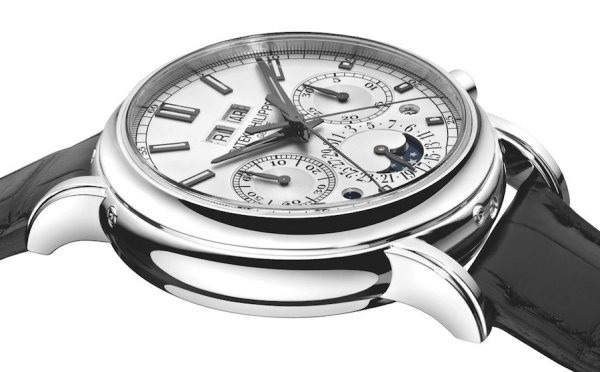
At Patek Philippe, topping themselves isn’t just a goal, it’s a mantra. And so they’ve proved again with the release of the Ref. 5204, a split-seconds chronograph with a perpetual calendar. The title sounds relatively simple compared to what this thing does. Let’s break it down. The Ref. 5204 tells time, obviously. For everyday use, this will be the function you’ll go to most, providing you don’t make it a safe queen.
In addition to telling time, the Ref. 5204 is a perpetual calendar. Not one you’ve got to reset several times a year (a regular calendar), or even once a year, twice if it’s a leap year (annual calendar) but never. That’s right, never! You don’t ever have to wonder where you are in the leap year cycle. If you keep it wound up. The Ref. 5204 will keep track of the Gregorian calendar long after you’ve kicked the bucket.
Now we come to the chronograph. A de rigeur complication for the sportsman, the chronograph breaks time into intervals. For example, in Los Angeles, you can time your meter so you don’t get a ticket or use it for barbecuing so you don’t make Uncle Bernie’s steak well-done when he likes it medium rare—or even time how long your Aunt Gladys keeps yapping at you before you can get away.
So you’ve got your perpetual calendar and chronograph, but that wasn’t enough for Patek Philippe. No, they wanted to top that chronograph summit with a split seconds. With a split seconds, you can measure intervals within intervals. There are two chronograph hands, one under the other. Once you make the split and note the time, the second hand catches up to the first (called a rattrapante) so you can mark another interval when you want to.

Patek Philippe reworked the splits function to include two innovations to optimize the alignment of the split-seconds hand and thus increase accuracy. They did this through an isolator for the splits-seconds lever, and a congruent alignment mechanism for the split- seconds hand and the chronograph hand, which qualified for a patent application.
When are you going to use a split seconds if you’re not a horse trainer or high-school coach? Probably never. Still, it’s a rad complication and fun to play with.
Such complicated watches tend to have fussy dials, making the functions more of an art than a practice. But Patek Philippe nailed a crisp layout with in-line apertures for the day of the week and month below 12 o’clock, while a moonphase and date dial balance out the picture at 6 o’clock. The upside moonphase adds a provocative design element. Sub seconds and jumping 30-minute chrono counter reside just below the horizontal centerline at 9 and 3 o’clock respectively. A quick look between 4 and 5 o’clock reveals the leap-year cycle and a day/night indicator looks out between 7 and 8 o’clock.
While Patek Philippe previously used the outsourced Lemania for its chronographs, in 2009 they introduced the in-house produced manually wound, column-wheel-controlled CH 29-535 PS. Of course you could still expect the meticulous finishing Patek Philippe is known for, the finishing that makes grown men practically break down in tears. Gentleman that they are, Patek Philippe made the chronograph Ref. 7071 for ladies first and made the men wait. Chivalry is not dead at Patek Philippe.

The Ref. 5204 steps it up a level (are you surprised?) and uses the in-house chrono caliber, culminating the brand’s expertise in producing a stunning triple-complication watch that demonstrates the utmost in technical virtuosity. It’s like doing a triple back flip with a half twist and sticking the landing.
I can’t wait to see it in other metals and perhaps with a rich Havana Brown dial, in a rose gold case and chocolate brown strap. Now that would be sweet.
Read a great explanation of the watch and technical innovations by Ron DeCorte here.

No hay comentarios:
Publicar un comentario